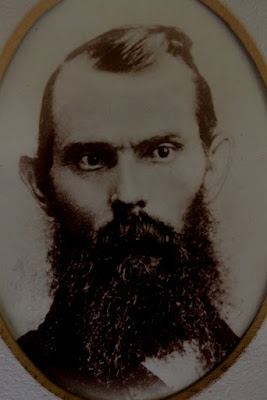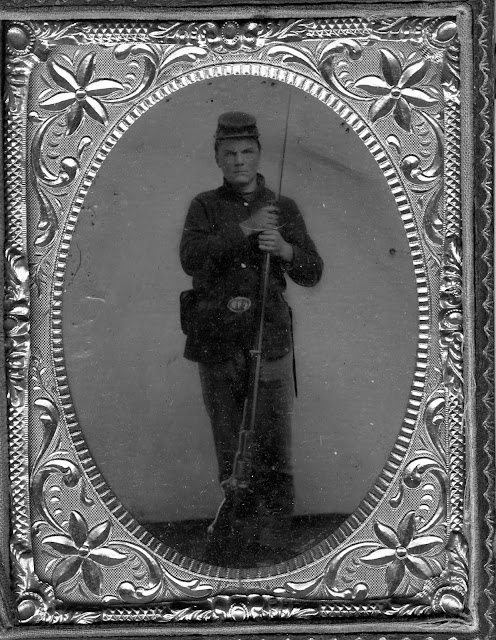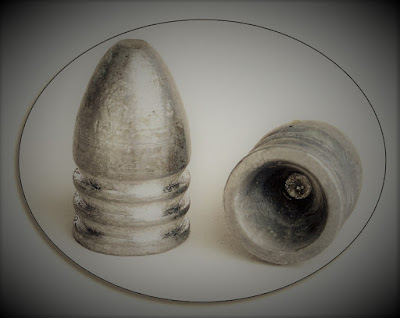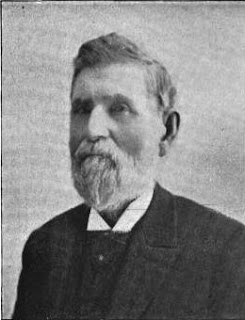The Magnolia Mission: Dr. John D. O'Connor Visits Shiloh
Dr.
John Deming O'Connor was born September 24, 1822 in Woodsfield, Monroe Co.,
Ohio to an Irish father Daniel O'Connor who had deserted the British army in
Canada shortly after the War of 1812. As remembered by lifelong friend William
Okey, Daniel felt that “he had served His Majesty long enough and imbued with a
love of our free institutions, he and two comrades crossed in a small boat from
Queenstown to the American shore, and, after remaining in New York a short
time, he came on foot to Wheeling, Virginia, then to Woodsfield.” His father
settled in Woodsfield in 1818 where he married and became a successful
politician, serving 30 years as the county recorder.
 |
| John D. O'Connor, Jr. The youngest son was said to have borne a striking resemblance to his father Dr. John D. O'Connor. |
John
O'Connor attended the local public schools but also received some private
instruction before becoming an apprentice in the office of Dr. Josiah M. Dillon
where he learned the practice of medicine. The newly minted doctor later set up
practice in the small town of Clarington at the confluence of Sunfish Creek and
the Ohio River in Monroe County, Ohio. “The doctor's practice extended along
the riverbank and the rough hills and mountains of Monroe,” wrote an acquaintance.
“He nearly wore out his life in the pursuit of his profession.” Seeking to
extend his medical knowledge, he took courses from Miami Medical College and
graduated in 1858. William Okey recalled that Dr. O'Connor never had robust
health, but was “wiry” and “performed an amount of labor in riding over the
hills of Ohio and Virginia that astonished his friends.” He married Ruth Neff
in 1845 and had seven children, one, a son, tragically drowned in Sunfish Creek
just before the outbreak of the Civil War. His children included Juliet (born
in 1846), Ellen Ione (born in 1848), Rebecca J. (born in 1855), John D., Jr.
(born 1863) and three others. A Democrat, Dr. O'Connor was elected to represent
the counties of Guernsey, Monroe, and Noble in the Ohio state Senate in the
November of 1861. He was re-elected to a second term in November 1863,
finishing his public services at the close of the Civil War.
A
fine description of Dr. O'Connor from the first session of the Ohio Legislature
on January 6, 1862 was given by his fellow Democrat senator Dr. William Lang of
Seneca County, Ohio. “Snow covered the earth and the air was very cold; the sky
was overcast with heavy clouds, and all nature looked gloomy and dreary and so
did the Senate chamber when at 10 o'clock on the morning of January 6, 1862.
The city of Columbus was full of soldiers; regiment after regiment was being
organized and sent to the front. The sound of martial music rang in the streets
day and night, and here met the first legislature of Ohio after the breaking
out of the Rebellion. The condition of the country on that morning seemed to
combine with nature to cast a gloom and sadness over the Senate. The Hon.
Benjamin Stanton, president of the Senate, took his seat; the members were
sworn and seated and the saddest countenance in that body was Senator John D.
O'Connor of Monroe. He was then about 40 years of age, about six feet high, and
had black hair brushed back from a high forehead, deeply set dark eyes, a
chiseled face, and a black beard covered his mouth and chin. Heavy black
eyebrows gave powerful expression to the whites of his eyes making his
countenance wonderfully striking. He was lean of flesh. The paleness of his
face and his entire make up were calculated to arrest the attention, if not
excite the sympathy, of the most careless observer. Add to this a prudent
reserve, close observation, quiet demeanor, and polished manners, and you have
a fair picture of Dr. O'Connor. Party spirits ran high during the war and the
few members of that body elected by Democratic constituencies were treated with
indifference for their votes were not necessary to carry any measure. Dr.
O'Connor and the writer belonged to that small number and as misery loves
company, it was not long until mutual respect warmed into warm friendship that
grew brighter as time rolled on and lasted for life.” (From William Lang's The
History of Seneca County from the close of the Revolutionary War to July 1880, Springfield:
Transcript Printing Co., pgs. 395-98)
As
a Democrat representing a heavily Democratic district, O'Connor was at times
harsh in his denunciation of the methods used by the state and federal
government in suppressing the Rebellion. However, even his opponents conceded
his unfailing patriotism. “I discovered that as loyal and patriotic heart beat
in his bosom as my own,” wrote Senator Neal. “However we might differ as to the
measures to be adopted and the means to be used, he was as earnestly desirous
to see the Rebellion crushed out and the Union maintained. He rejoiced in the
success of our armies, gloried in their victories, and mourned over their
defeats.”
Dr.
O'Connor was particularly interested in the condition of a local company, Co. A
of the 77th Ohio Volunteer Infantry. Initial reports suggested that
the 77th Ohio had fled ingloriously at the first fire, reports later
shown to be false. Below is O'Connor's account of his travels to Pittsburg
Landing as reported in the Woodsfield Spirit of Democracy issue of April
30, 1862. I’ve interspersed some reports from others members of the expedition
to help flesh out O’Connor’s account.
Dr. John D. O’Connor:
Upon
receipt of the intelligence here on the 9th instant of the terrible
battle at Pittsburg Landing, Tennessee on the 6th, 7th,
and 8th, I volunteered as a surgeon, and in company with Lieutenant
Governor Stanton, Surgeon General Webber, and several physicians of the General
Assembly, started for the battlefield.
The
state authorities chartered at Cincinnati a splendid steamer, the Magnolia,
and after a few hours spent in procuring cots, beds, bedding, clothing,
hospital stores, etc., we were on our way to the Austerlitz of America. On our
way we removed all the furniture from the cabins, set our table on the guard
forward of the wheelhouse on one side and enclosed the balance of the guards
with rough planks so as to make as much room as possible for the sick and
wounded. We arrived at Pittsburg Landing on Sunday morning [April 13, 1862]. We
had our beds, some 250, all spread, our medicine and instruments arranged, and
in a word, a floating hospital for the reception of our brave soldiers who had
sickened in the service or had been wounded in the battles in which so many of
Monroe's brave sons fell.
The
boat landed at 10 o'clock Sunday morning. The volunteer corps of physicians
were divided into parties of five and started out over the battlefield to
gather up the sick and wounded and bring them into the boat. I will not attempt
to describe this field of carnage, and of the triumph of our arms, but leave it
for others and perhaps more graphic pens.
Dr. Elisha Hyatt:
The
first thing that met the eye was the operation on a poor wounded soldier,
amputation at the shoulder joint, injury was a gunshot wound. The suffering
is untold and can never be described. When we arrived, it was the seventh day
after the fight ended, yet there were hundreds lying in tents uncared for, so
far as medical or surgical aid is concerned. Their comrades had given them
something to eat, but there they lay on their blankets, saturated with mud and
water, with mutilated bodies, torn and fractured limbs, many of which was
getting gangrene, and hundreds died in this condition for the want of timely
aid. Our load numbered 240, most of who were severely wounded, and with but very
few exceptions, their wounds were undressed.” (Dr. Hyatt had briefly served as
captain of Co. A, 20th Ohio Infantry, resigning his commission to
date February 24, 1862. Delaware Gazette,
April 25, 1862)
Dr. Charles
Cochran:
There
were perhaps 30 steamers at the Landing when we arrived, some just arrived,
others already freighted with wounded soldiers. Steam whistles were sounding,
bells ringing, cavalry galloping, army wagons moving, regiments marching,
squads of four soldiers each following each other, bearing a suffering comrade
from the camp hospital to the boats, the yelling of teamsters, the braying of
mules, and last, though not least, the groans of the wounded, all mingled
making a confusion confounded such as is seldom heard. (Daily Toledo Blade, April 21, 1862)
Dr. John D. O’Connor:
My
first effort was to find the regiments from the eastern part of the state and
especially those having in them troops from Monroe, Noble, Guernsey,
Washington, and Belmont Counties. When I at last reached them, I found that
many of the sick and wounded from our part of the state had been sent away
before our arrival; some to Mound City, Illinois, some to St. Louis, Missouri,
and others to Cairo, Illinois, New Albany, Indiana, Evansville, Indiana, and Cincinnati,
Ohio. I gathered up all of the sick and wounded that I could find from the 77th
Ohio and other regiments that belonged to Monroe and got them aboard. I also
brought with me to Cincinnati the remains of Second Lieutenant Joseph J.
Steenrod, [Co. A, 77th Ohio] who fell in a charge at the head of his
company on Monday the 7th, was mortally wounded, and died on the 8th.
Before leaving the boat, I re-shipped the body to his friends in Sunfish.
I
also had under my care Lieutenant William W. Scott of Marietta [Co. I, 77th
Ohio], who was wounded in the chest, the ball passing through the right lung
and out through the shoulder blade. He was doing well and walked up the landing
with me at Cincinnati to the Marietta packet, and was put in care of kind
friends to conduct him safely home. He is a noble fellow and will yet do good
service for his country. Marietta may well be proud of such men. I had a list
of men from Monroe that came up on the Magnolia, but have mislaid it,
and can now only remember the names of Abraham Messer, Mr. Grim, Smith, Coon,
and Scott. There were some four or five others that were left with them in
hospital at Camp Dennison, near Cincinnati.
 |
| The wounded men aboard the Magnolia were quickly transferred to the post hospital at Camp Dennison along the banks of the Miami River near Cincinnati, Ohio. |
Dr. Charles
Cochran:
As
each victim, borne on a stretcher, crossed the gangplank, he was divested of
his mud-bespattered blood-stained clothing, carefully washed and wiped, given a
clean shirt and drawers, then was tenderly laid on his cot. The next sufferer
took the next cot and so the work progressed until every cot on the boat had
its suffering occupant. The whole number of patients on our boat was divided
into wards with from 15 to 20 in each. Each ward was placed in charge of one
surgeon and two or more nurses. Early in the morning our patients were to be
washed and their persons made as neat as possible; after which their breakfast
was served which was usually beef or chicken broth, served from the kitchen in
pails. Each soldier had his pint cup and spoon and he was abundantly supplied
with bread. Sometimes instead of soup, he is served coffee and sandwiches made
of bread and dried beef or concentrated chicken. After breakfast the wounds are
dressed, the sick prescribed for, and medicines dispensed, which takes up the
greater part of the forenoon. Dinner is served about 1 o’clock and is very much
like breakfast, only perhaps a little more substantive in its character. The
afternoon is spent much like the morning by the surgeons and nurses for there
is seldom at any time any long interval in which they are not called upon to
relieve some pain, change some dressing, slightly alter a patient’s position,
or do something to contribute to his comfort. There comes every fifteen minutes
or so a shrill shriek uttered by some brave fellow caused by the awkward
attempt of the attendant to move a wounded limb.
Dr. Elisha H.
Hyatt:
Our boat started and the work commenced. Coats
were thrown off and to work we went with in good earnest. Limbs were amputated,
bullets extracted, fractures dressed, and all other wounds that could be named
were attended to, both nurses and surgeons having no rest day or night. With
the best attention that could be rendered these poor sufferers, many died on
the way and were buried at different landings. When we arrived at Cincinnati,
we had 216 yet alive out of 240. We were then compelled to ship them aboard the
cars and take them to Camp Dennison to the hospital. Their re-shipping operated
very unfavorably to their recovery.
Dr. John D. O’Connor:
The
state authorities sent out another boat yesterday to visit the various points
to which the sick and wounded Ohio troops had been transported, and set out to
bring them back to Ohio. I should have accompanied this expedition also, but
was so completely used up by the trip on the Magnolia that I was
satisfied that I would have to be cared for by others before the boat returned.
I, therefore, with the other physicians of the General Assembly, reluctantly
declined this second trip.
I
will say here, for the satisfaction of those who have friends in the army, that
all of the Ohio sick and wounded will be brought here to this state as fast as
possible; and those who can be, or are in condition to be sent home to their
friends to be nursed up, will be sent as soon as the necessary forms can be
passed through. This assurance with the list of sick and wounded of the 77th
Ohio will give the friends as much information as it is possible for me to give
without entering into unwarranted details.
It
may, however, be expected that I should briefly give the result of the battle
as I learned it on the ground. Adjutant Arely Robertson, 17th
Alabama Vols [no record of this name is found associated with the 17th
Alabama] , a wounded prisoner under my care, informed me that Beauregard's army
laid down on Saturday night, before the battle Sunday, on their arms in regular
order of battle and so close to our lines that they could see into our tents.
They made a general attack about daylight, captured General Prentiss and two
regiments of troops at their breakfast, and completely routed several others.
Before our batteries could be brought into position, the entire west line was
driven some two miles in towards the river, the most of this distance being a
regular hand to hand encounter, our men using their bayonets and the Rebels
their cleavers, made by country blacksmiths from old files. By the middle of
the afternoon, our batteries were doing good service; the men had recovered from
their surprise and the advance of the Rebels was checked. They rested upon
their arms at dark.
General
[Don Carlos] Buell crossed the river with reinforcements during the evening and
night of Sunday. The Rebels were also reinforced by 65 carloads of troops that
landed near Corinth from Richmond on Saturday evening. With this addition to
his forces, General Beauregard felt so confident of success and of making a
complete capture of our army, that he declared (so I am informed) that he would
'water his horses in the Tennessee in the morning or in Hell.' But sad reverse
to his fond hopes- at 4 o'clock our batteries commenced playing upon them and
our infantry that had been out all night without food and in a severe rain,
slowly commenced the advance. By noon, the rout of the Rebels had become
general and before night the enemy had been driven completely beyond our lines.
I had the pleasure of spending an hour with the Monroe boys in a tent used by a
Rebel general as his headquarters on Sunday night.
 |
| Colonel Jesse Hildebrand, 77th O.V.I. |
The
77th Ohio under Colonel Jesse Hildebrand was in the front of
Sherman's division all day Sunday, lay all night in the rain and on Monday was
again in front all day. Officers of the 49th, 58th, and
15th Ohio informed me that the valor of the 77th Ohio
prevented the Rebels from turning our left wing on Monday. On Tuesday this new
regiment, after being two days in front of the hardest fought battle on the
continent without food or rest, were taken out to support a battery some miles
in advance of the main body. Here they encountered a large body of Rebel
cavalry and were completely cut to pieces. The general of the division
[Sherman[ in his report to General Grant imputes a want of efficiency, to say
the least of it, to a set of as brave men as ever stood upon a battlefield. I
am fully satisfied that more blame should attach to many of the shoulder strap
gentry than to the brave, exhausted infantry who stood the charge of superior
numbers of cavalry until they were cut to pieces.
These
recreant commanders of divisions have at this time the subordinate officers and
men under their military control; that the time will come when this restraint
will be removed, and these subordinates and privates will furnish the materials
for many of the pages of the history of the Rebellion of 1861 and 1862, and
when the jewels of the great battle of Pittsburg Landing or Shiloh Chapel is
made up, the 77th Ohio will hold no inferior position. The list of
her killed and wounded speaks in thunder tones of the intrepid valor and
unflinching courage of Ohio's brave boys, who did such efficient service on the
6th, 7th, and 8th of April.
Among
the trophies picked up on the battlefield was the Charleston Mercury of
April 3rd. I find in it a call upon all the churches to send their
bells to the Confederate arsenals in order that they may be converted into
cannon, the government promising to pay the value, or return a similar bell at
the close of the war. Another curiosity is an editorial calling the attention
of the citizens to an advertisement of a grocer who notifies his patrons that
he 'has received through the blockade two casks of English cured hams for which
he has paid 81 cents per pound, and will sell them at retail at a small
advance.' Comment is unnecessary. When our Southern friends eat bacon at 81 to
100 cents per pound, there must be some efficiency in the paper blockade.
| Dr. William Lang of Tiffin, Ohio |
After
the war, his friend Dr. William Lang visited Dr. O'Connor in Clarington and
suggested that O'Connor pull up stakes and try his practice in Seneca County,
Ohio in the northwest part of the state. As the good doctor's health had been
under considerable strain and he desired to send his daughters to good
schools, the doctor agreed to consider the idea. The O'Connor family visited
Tiffin shortly thereafter and in October 1866 elected to move, purchasing a
farm south of Tiffin. Once in Seneca County, O'Connor set up another medical
practice which proved to be a lucrative one. “He stepped at once into the front
rank of his profession where he was highly esteemed and became so popular among
the people that they elected him the delegate from this county to the state
constitutional convention in 1873.”
However,
Dr. O'Connor's health did not improve with the change of locale; mention is
made of him having weak lungs. He was attending the constitutional convention
sessions when he took ill and, at his own request, was sent to the Good
Samaritan Hospital in Cincinnati where he languished for two weeks. John D.
O'Connor died there February 21, 1874 aged 51, leaving his wife and six
children. A delegation from the convention escorted the body back to Tiffin
where it was met at the train depot by the members of the Medical Society, a
contingent from the Masonic Order, and other citizens. After a well attended
funeral, his body was laid to rest in Greenlawn Cemetery. The state constitutional
convention spent the afternoon of February 26, 1874 giving tributes to Dr.
O'Connor. One of the tributes specifically remembered O'Connor for his
sincerity, earnestness, determination, sincerity of conviction, earnestness of
purpose in carrying out his convictions, and determination to stand to his
colors no matter how strongly opposed. ('Death of Hon. John D. O'Connor, Tiffin
Tribune, February 26, 1874, pg. 3, also Official Report of the
Proceedings and Debates of the Third Constitutional Convention of Ohio,
Volume 2, Part 2, 1874)










Comments
Post a Comment